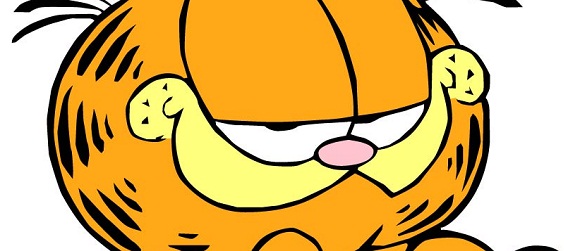At Long Last, Garfield the Cat Exposed in Tell-All ‘Like Water for Lasagna’
By Kelsey Osgood

From Dean Ortega, the author who brought you the inside scoop on the rift that tore apart Calvin and Hobbes, comes the biography of America’s favorite corpulent cat, Garfield. Like Water for Lasagna: the Garfield Story begins right where you would hope: on June 19th, 1978, when Garfield appeared, fully-grown, in the kitchen of Mama Leoni’s Italian Restaurant in the hamlet of Muncie, Indiana.
Ortega painstakingly recreates many events from Garfield’s kitten-hood, including his first pizza binge, his subsequent exile from Mama Leoni’s, and finally, his adoption by Jon Q. Arbuckle. He was able to accomplish such a feat by interviewing numerous friends and acquaintances of Garfield’s at length, including Nermal the kitten, Odie, Jon’s brother Doc Boy, and surly diner owner Irma. While Garfield himself loathes press -- despite freely licensing his images to merchandisers -- and refused to be interviewed for the biography, Arbuckle spoke at length to Ortega.
Now sixty-three and in a long-term committed relationship with Dr. Liz Wilson -- fans will know her as Garfield’s vet -- Arbuckle seems to have forgiven Garfield for his many foibles over the years. "Of course, once I settled down with a lady," Arbuckle tells Ortega, "it was easier to forget all the times Garfield made fun of me for being a single loser." Arbuckle refuses, however, to answer the allegations of plastic surgery that have been lobbed at him due to his freakishly young visage.
Whereas Arbuckle comes off as a lovable dork, Garfield is portrayed as snarky, self-centered, and apathetic. Yet, to Ortega’s credit, his subject doesn't become unlikable. In fact, no matter how many times Garfield kicks Odie off the table (Ortega does touch upon the 1999 harassment lawsuit Odie filed against Garfield, which was settled out of court) the reader finds himself siding with the obese tabby. Perhaps it’s due to his hardscrabble beginnings, the fact that he was orphaned, or a result of his heartbreaking struggle with compulsive overeating (Garfield, by the way, seems to only occasionally acknowledge this, perhaps because it is too painful to confront).When the reader hears of his out-of-control binges and merciless fear of aging, he is forced to wonder whether Garfield’s anhedonic exterior is simply a façade to mask a pain too great to bear. With new awareness, it is now difficult to think of Garfield’s annual "National Fat Week" -- during which he lambastes thin people -- as quite so humorous anymore.
Not to say that Ortega’s book answers all of the lingering questions about Garfield. For instance, he does not delve too deeply into the divine figure of Jim Davis, Garfield’s spectral "creator," nor does he lay to rest the question of whether or not Jon Arbuckle can understand Garfield. ("Perhaps Jon understands Garfield," he writes, somewhat sappily, "the way a mother understands a toddler who, to others, seems to be speaking gibberish.") Despite these journalistic oversights, Like Water for Lasagna is a fascinating, thrilling, and, above all, emotional read.
(Note to readers: the above is, obviously, complete farce. One might do better to call it a "plea," as we’re hoping that someone will be inspired by it and take it upon themselves to chronicle Garfield’s life. But for those looking for a quick Garfield fix, you'll find the new Garfield Souped Up a suitable substitute until someone finally spills the beans on this furry feline.)
For additional biographies the world desperately needs, visit our series here.
